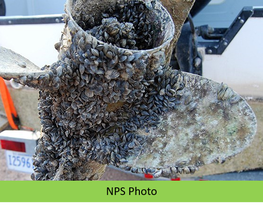
Protecting our Waterways Design Challenge: Zebra Mussels
By Jessica Wagonmaker and Jessica Vander Ark
CLICK ON IMAGE TO DOWNLOAD A PRINTABLE VERSION OF THIS LESSON PLAN
We would greatly appreciate your feedback! Click here to complete a short survey telling us about your experience with this lesson plan.
By Jessica Wagonmaker and Jessica Vander Ark
CLICK ON IMAGE TO DOWNLOAD A PRINTABLE VERSION OF THIS LESSON PLAN
We would greatly appreciate your feedback! Click here to complete a short survey telling us about your experience with this lesson plan.
Lesson Overview
This lesson introduces students to the engineering design process- the process engineers use to solve design challenges. Students work in pairs to solve the challenge by designing a scrubber that would clean the hulls of ships, motors of ships and/or drain systems attached by Zebra Mussels. Students learn about the engineering process by completing an engineering design challenge where they will design and produce a product to solve a problem.
Target Grade: Grade level 3-12
Duration: Three 45 min class periods
Learning Objectives
At the end of the lesson students will be able to:
List Materials & Quantities
1. Student worksheets
Protecting Our Waterways Design Challenge - Student Group worksheet
2. Design Challenge Evaluation Worksheet
3. Zebra Mussel Information sheet
4. Large paper or white board for each group and markers
5. Poster with steps of engineering design process to post in classroom or student handout
(https://www.sciencebuddies.org/science-fair-projects/engineering-design-process/engineering-design-process-steps)
Focus Question: How can we construct a scrubber that would clean the hulls, motors and/or drain systems of ships to which Zebra Mussels attach?
Classroom Activities
Assessment of Student Learning
Student groups will be graded on their overall design model and explanation.
Individuals will be graded on the completion of their design challenge evaluation worksheet.
Extension Activities
Students may use building materials to construct their prototype. Once all prototypes are constructed, students can discuss each and select the best.
Science Standards Addressed (https://ngss.nsta.org/DisplayStandard.aspx?view=topic&id=31)
MS-LS2-5 Evaluate competing design solutions for maintaining biodiversity and ecosystem services.
Engineering Standards Addressed
3-5-ETS 1-1 Define a simple design problem reflecting a need or a want that includes specified criteria for success and constraints on materials, time, or cost. 3-5-ETS1-1
3-5-ETS 1-2 Generate and compare multiple possible solutions to a problem based on how well each is likely to meet the criteria and constraints of the problem. 3-5-ETS1-2
3-5-ETS 1-3 Plan and carry out fair tests in which variables are controlled and failure points are considered to identify aspects of a model or prototype that can be improved. 3-5-ETS1-3
SEP + CCC + DCIs: https://ngss.nsta.org/DisplayStandard.aspx?view=topic&id=23
https://ngss.nsta.org/DisplayStandard.aspx?view=topic&id=23
MS-ETS 1-1 Define the criteria and constraints of a design problem with sufficient precision to ensure a successful solution, taking into account relevant scientific principles and potential impacts on people and the natural environment that may limit possible solutions. MS-ETS1-1
MS-ETS 1-2 Evaluate competing design solutions using a systematic process to determine how well they meet the criteria and constraints of the problem. MS-ETS1-2
HS-ETS 1-2 Design a solution to a complex real-world problem by breaking it down into smaller, more manageable problems that can be solved through engineering. HS-ETS1-2
HS-ETS 1-3 Evaluate a solution to a complex real-world problem based on prioritized criteria and trade-offs that account for a range of constraints, including cost, safety, reliability, and aesthetics as well as possible social, cultural, and environmental impacts. HS-ETS1-3
The Engineering Design Process
https://www.sciencebuddies.org/science-fair-projects/engineering-design-process/engineering-design-process-steps
Step 1- Identify the problem What is the problem you want to solve?
Step 2- Research the problem What do you already know about the problem? Find out all you can about this problem. What is the criteria or conditions this solution must work into? What are the constraints or issues that could hold back your success?
Step 3- Develop Possible Solutions Brainstorm all solutions to this issue
Step 4- Select the best possible solution Which of your ideas do you think is the best solution?
Step 5- Design a blueprint Draw and label your design
Step 6- Build a prototype Discuss with your group your blueprint.
Step 7-Test & redesign Change your design to make it better.
Step 8- Communicate During each step of the process the team should be in constant communication.
This lesson introduces students to the engineering design process- the process engineers use to solve design challenges. Students work in pairs to solve the challenge by designing a scrubber that would clean the hulls of ships, motors of ships and/or drain systems attached by Zebra Mussels. Students learn about the engineering process by completing an engineering design challenge where they will design and produce a product to solve a problem.
Target Grade: Grade level 3-12
Duration: Three 45 min class periods
Learning Objectives
At the end of the lesson students will be able to:
- Explain how the characteristics of the Zebra Mussel make it successful in the Great Lakes Ecosystem.
- Describe how the engineering design process (EDP) can be applied to solve a design challenge.
- Build, test and redesign a prototype.
- Employ teamwork and communication to successfully solve a challenge
List Materials & Quantities
1. Student worksheets
Protecting Our Waterways Design Challenge - Student Group worksheet
2. Design Challenge Evaluation Worksheet
3. Zebra Mussel Information sheet
4. Large paper or white board for each group and markers
5. Poster with steps of engineering design process to post in classroom or student handout
(https://www.sciencebuddies.org/science-fair-projects/engineering-design-process/engineering-design-process-steps)
Focus Question: How can we construct a scrubber that would clean the hulls, motors and/or drain systems of ships to which Zebra Mussels attach?
Classroom Activities
- Break class into design teams
- Hand out Zebra Mussel Information Sheet
- Discuss the Engineering Design Process: Identify the Problem, select best possible solution, construct a prototype, Test the solution, Redesign, Communicate your findings
- Explain that the students have been assigned to construct a scrubber that would clean the hulls of ships, motors of ships and/or drain systems attached by Zebra Mussels. They will have one class period to discuss, design and draw a blueprint of their solution. This blueprint should give a detailed explanation of the materials involved and a breakdown of the construction.
- Provide each team with one piece of white large paper or white board to draw their design and write out their final process. Each group must be prepared to explain their design and process to the class.
- They will have one class period to complete the illustration and explanation of the final process as well as prepare their presentation.
- Student groups present their solution to the class. After the presentation, the class will discuss the solution and give suggestions to the group. At the conclusion of all the presentations, each group will be given time to redesign their solution before submitting the finished design.
- Students fill out the Design Challenge Evaluation Worksheet
Assessment of Student Learning
Student groups will be graded on their overall design model and explanation.
Individuals will be graded on the completion of their design challenge evaluation worksheet.
Extension Activities
Students may use building materials to construct their prototype. Once all prototypes are constructed, students can discuss each and select the best.
Science Standards Addressed (https://ngss.nsta.org/DisplayStandard.aspx?view=topic&id=31)
MS-LS2-5 Evaluate competing design solutions for maintaining biodiversity and ecosystem services.
Engineering Standards Addressed
3-5-ETS 1-1 Define a simple design problem reflecting a need or a want that includes specified criteria for success and constraints on materials, time, or cost. 3-5-ETS1-1
3-5-ETS 1-2 Generate and compare multiple possible solutions to a problem based on how well each is likely to meet the criteria and constraints of the problem. 3-5-ETS1-2
3-5-ETS 1-3 Plan and carry out fair tests in which variables are controlled and failure points are considered to identify aspects of a model or prototype that can be improved. 3-5-ETS1-3
SEP + CCC + DCIs: https://ngss.nsta.org/DisplayStandard.aspx?view=topic&id=23
https://ngss.nsta.org/DisplayStandard.aspx?view=topic&id=23
MS-ETS 1-1 Define the criteria and constraints of a design problem with sufficient precision to ensure a successful solution, taking into account relevant scientific principles and potential impacts on people and the natural environment that may limit possible solutions. MS-ETS1-1
MS-ETS 1-2 Evaluate competing design solutions using a systematic process to determine how well they meet the criteria and constraints of the problem. MS-ETS1-2
HS-ETS 1-2 Design a solution to a complex real-world problem by breaking it down into smaller, more manageable problems that can be solved through engineering. HS-ETS1-2
HS-ETS 1-3 Evaluate a solution to a complex real-world problem based on prioritized criteria and trade-offs that account for a range of constraints, including cost, safety, reliability, and aesthetics as well as possible social, cultural, and environmental impacts. HS-ETS1-3
The Engineering Design Process
https://www.sciencebuddies.org/science-fair-projects/engineering-design-process/engineering-design-process-steps
Step 1- Identify the problem What is the problem you want to solve?
Step 2- Research the problem What do you already know about the problem? Find out all you can about this problem. What is the criteria or conditions this solution must work into? What are the constraints or issues that could hold back your success?
Step 3- Develop Possible Solutions Brainstorm all solutions to this issue
Step 4- Select the best possible solution Which of your ideas do you think is the best solution?
Step 5- Design a blueprint Draw and label your design
Step 6- Build a prototype Discuss with your group your blueprint.
Step 7-Test & redesign Change your design to make it better.
Step 8- Communicate During each step of the process the team should be in constant communication.

New lesson plan ideas are welcome and will be uploaded as they are received and approved.
Instructions for submitting lesson plans for:
About invasive species,
About science and science careers
For information about submitting new lesson plans, please contact jchadde(at)mtu.edu
Lesson plan ideas from other web sites:
From Pennsylvania Sea Grant: 10 lesson plans about interactions of invasive species, biodiversity, and climate change
Creation of the above page of educational resources was funded in part by the Michigan Invasive Species Grant Program through the Departments of Natural Resources, Environmental Quality, and Agricultural and Rural Development.
This material is also based upon work supported by the National Science Foundation under Grant No. 1614187.
Any opinions, findings, and conclusions or recommendations expressed in this material are those of the authors and do not necessarily reflect the views of the National Science Foundation.